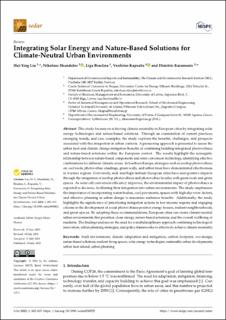| dc.description.abstract | This study focuses on achieving climate neutrality in European cities by integrating solar energy technologies and nature-based solutions. Through an examination of current practices, emerging trends, and case examples, the study explores the benefits, challenges, and prospects associated with this integration in urban contexts. A pioneering approach is presented to assess the urban heat and climate change mitigation benefits of combining building-integrated photovoltaics and nature-based solutions within the European context. The results highlight the synergistic relationship between nature-based components and solar conversion technology, identifying effective combinations for different climatic zones. In Southern Europe, strategies such as rooftop photovoltaics on cool roofs, photovoltaic shadings, green walls, and urban trees have demonstrated effectiveness in warmer regions. Conversely, mid- and high-latitude European cities have seen positive impacts through the integration of rooftop photovoltaics and photovoltaic facades with green roofs and green spaces. As solar cell conversion efficiency improves, the environmental impact of photovoltaics is expected to decrease, facilitating their integration into urban environments. The study emphasizes the importance of incorporating water bodies, cool pavements, spaces with high sky-view factors, and effective planning in urban design to maximize resilience benefits. Additionally, the study highlights the significance of prioritizing mitigation actions in low-income regions and engaging citizens in the development of social photovoltaics-positive energy houses, resilient neighbourhoods, and green spaces. By adopting these recommendations, European cities can create climate-neutral urban environments that prioritize clean energy, nature-based solutions, and the overall wellbeing of residents. The findings underscore the need for a multidisciplinary approach combining technological innovation, urban planning strategies, and policy frameworks to effectively achieve climate neutrality. | en_US |

